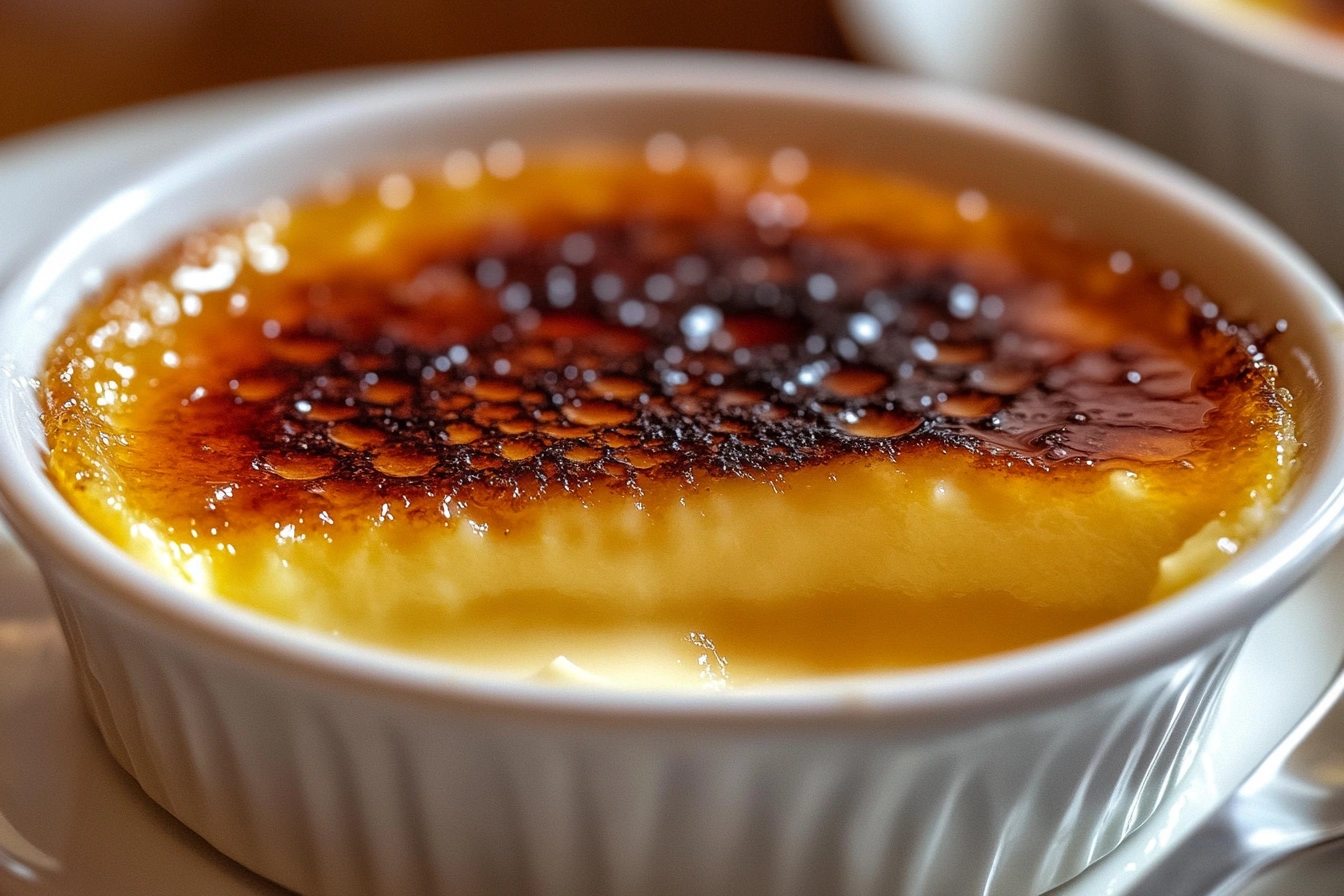Understanding the Role of Cream in Crème Brûlée
1. Introduction: Why Cream Matters in Crème Brûlée (200 Words)
Crème brûlée is one of the most iconic French desserts, known for its luxuriously smooth and creamy custard, topped with a crisp, caramelized sugar crust. While the recipe itself is simple, the key to achieving its signature texture lies in choosing the right type of cream. and let’s discover What Type of Cream Is Best for Crème Brûlée
Cream is the most crucial ingredient in crème brûlée because it determines:
- Texture – The higher the fat content, the richer and silkier the custard.
- Consistency – A properly set custard is thick yet delicate, without being too firm.
- Stability – Cream helps prevent curdling, ensuring a smooth, cohesive custard.
The fat content in cream plays a major role in how well the custard sets. Too much fat can make the custard dense, while too little fat may result in a watery, unstable texture. Traditionally, heavy cream (36-40% fat) is the best choice because it provides the perfect balance of richness and smoothness.
Understanding the different types of cream and their impact on crème brûlée will help you select the best option for a flawless dessert. In this section, we’ll explore which cream is traditionally used, alternative options, and how fat content affects texture and flavor.
Table of Contents
2. What Type of Cream is Traditionally Used? (250 Words)
Heavy Cream (aka Heavy Whipping Cream) – The Best Choice
The traditional and best cream for crème brûlée is heavy cream, also known as heavy whipping cream.
- It contains 36-40% fat, making it the perfect balance of richness and stability.
- The high fat content helps create a smooth, velvety texture without the risk of curdling.
- Heavy cream also enhances the luxurious mouthfeel of crème brûlée, giving it a decadent quality.
Alternatives Used in Some Recipes
Some variations of crème brûlée use different types of cream for a lighter or richer texture:
- Half-and-Half (Light Cream) – Lighter texture, but less richness
- Contains 10-18% fat, making it too thin for traditional crème brûlée.
- The custard may not set properly, resulting in a runny texture.
- Double Cream – Higher fat content, extra indulgent texture
- Contains 48%+ fat, making it even richer than heavy cream.
- Used in some European recipes, but may be too thick and difficult to find.
- Whipping Cream – Slightly lower fat (30%), still works but less stable
- Contains 30-35% fat, meaning it can be used, but won’t be as stable as heavy cream.
- May require slightly longer baking time to achieve a perfect set.
While some substitutions are possible, heavy cream remains the gold standard for achieving the best texture and flavor in crème brûlée.
3. Comparing Different Types of Cream (300 Words)
Understanding the fat content of different creams helps determine which works best for crème brûlée. Below is a comparison of popular cream options:
| Cream Type | Fat Content | Best For Crème Brûlée? |
|---|---|---|
| Heavy Cream | 36-40% | ✅ Best choice for traditional crème brûlée |
| Whipping Cream | 30-35% | ✅ Works, but slightly less stable |
| Half-and-Half | 10-18% | ❌ Too light, may result in runny custard |
| Double Cream | 48%+ | ✅ Extra rich but harder to find |
| Light Cream | 18-30% | ❌ Too low in fat, custard may not set properly |
How Fat Content Affects Texture and Flavor
- Higher fat (36-40%) = Richer, smoother, and more stable custard.
- Lower fat (<30%) = Thinner consistency, higher risk of curdling.
- Fat also enhances flavor, making the custard taste more decadent.
Why Lower-Fat Creams Don’t Work Well for Crème Brûlée
Using low-fat creams like half-and-half or light cream can result in:
- Watery custard that doesn’t set properly.
- Inconsistent texture that feels grainy or thin.
- A less luxurious mouthfeel, making the dessert less indulgent.
For the best results, always choose heavy cream to ensure your crème brûlée is creamy, rich, and perfectly set.

How to Choose & Use the Best Cream for Crème Brûlée
4. How to Choose the Right Cream for the Best Texture (250 Words)
Why Fat Content is Key to Avoiding Curdling
Fat plays a crucial role in stabilizing the custard and preventing the eggs from curdling. The higher the fat content, the smoother and creamier the crème brûlée will be. Using low-fat cream or milk increases the risk of a runny, unstable custard that won’t set properly.
Using a Combination of Creams for a Custom Texture
Some chefs experiment with different cream combinations to adjust the richness:
- Heavy Cream + Half-and-Half (70:30 ratio) – Lightens the texture slightly while maintaining creaminess.
- Heavy Cream + Whole Milk (50:50 ratio) – Produces a lighter custard, but with reduced richness.
- Double Cream + Heavy Cream (50:50 ratio) – Creates an ultra-rich and decadent texture.
How Ultra-Pasteurized Cream Affects the Custard
Ultra-pasteurized cream is heated to a higher temperature during processing, which extends shelf life but also changes its structure.
- Pros: Still works in crème brûlée and is widely available.
- Cons: Can produce a slightly grainy or less smooth texture.
- Best Choice: Use regular pasteurized heavy cream if available.
To achieve a perfectly creamy, indulgent texture, stick to high-fat, high-quality heavy cream.
5. Can You Use Non-Dairy Cream Alternatives? (200 Words)
If you’re looking for dairy-free alternatives for crème brûlée, it’s important to choose a substitute with a high fat content to mimic heavy cream.
1. Coconut Cream – The Best Non-Dairy Option
- Contains high fat (20-25%), providing a rich and creamy texture.
- Adds a mild coconut flavor, which can alter the traditional taste.
- Works best when combined with a stabilizer like cornstarch.
2. Cashew or Almond Cream – Lighter, Needs Stabilizers
- Lower in fat compared to coconut cream.
- Needs added thickening agents like cornstarch or agar agar.
- Produces a mildly nutty flavor.
3. Oat or Soy Cream – Too Watery, Needs Thickening Agents
- Oat and soy-based creams are too low in fat, leading to a less stable custard.
- Must be thickened with cornstarch or blended with a fat-rich ingredient (e.g., coconut oil).
How Non-Dairy Creams Affect the Caramelization Process
Dairy-based custards contain natural milk proteins, which help create a smooth, caramelized sugar top. Non-dairy versions may:
- Absorb more moisture, making the sugar layer less crisp.
- Require a thicker sugar layer to achieve the classic crunch.
While non-dairy options can work, they require adjustments in texture, fat content, and caramelization techniques.
6. Common Mistakes When Choosing Cream (250 Words)
Even when using high-quality ingredients, choosing the wrong type of cream can ruin crème brûlée’s signature texture. Here are common mistakes and how to avoid them:
1. Using Low-Fat Creams – Leads to Runny, Unstable Custard
- Problem: Low-fat creams (like half-and-half or light cream) contain too much water, leading to thin, unstable custard.
- Solution: Use heavy cream with at least 36% fat for a firm, rich consistency.
2. Substituting Milk for Cream – Custard Won’t Set Properly
- Problem: Milk lacks enough fat to bind with the eggs, resulting in a loose, watery texture.
- Solution: If using milk, mix it with heavy cream to maintain the right fat ratio.
3. Using Sweetened Creams – Can Make the Dessert Too Sugary
- Problem: Some creams (like pre-sweetened whipping cream) contain added sugar, which can throw off the balance of the recipe.
- Solution: Always use unsweetened cream and adjust sugar levels manually.
4. Using Expired or Ultra-Pasteurized Cream – May Result in Grainy Texture
- Problem: Ultra-pasteurized cream can cause a slightly grainy texture due to its higher heat treatment.
- Solution: Opt for regular pasteurized heavy cream when possible.
By avoiding these mistakes, you ensure a silky-smooth, rich, and perfectly set crème brûlée.
7. Frequently Asked Questions (FAQs) (300 Words)
1. What is the best cream for crème brûlée?
The best cream is heavy cream (36-40% fat) because it provides the rich texture and stability needed for a perfectly smooth custard.
2. Can I use half-and-half instead of heavy cream?
Yes, but it reduces the richness and may result in a thinner custard. If using half-and-half, consider mixing it with heavy cream for better texture.
3. Is heavy whipping cream the same as heavy cream?
Yes! Both heavy whipping cream and heavy cream contain 36-40% fat, making them interchangeable in crème brûlée.
4. Can I make crème brûlée with milk instead of cream?
No, milk lacks the necessary fat content to create a stable custard. It will likely result in a runny, loose texture.
5. What happens if I use ultra-pasteurized cream?
Ultra-pasteurized cream can create a slightly grainy or less smooth custard, but it still works. If using it, strain the custard mixture before baking for a smoother texture.
By choosing the right cream, you can ensure your crème brûlée is rich, creamy, and flawlessly set every time. 🍮🔥

